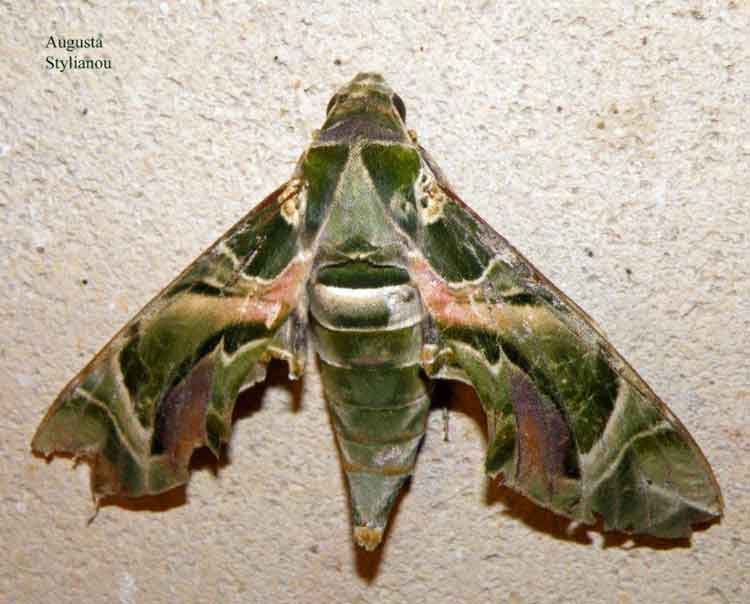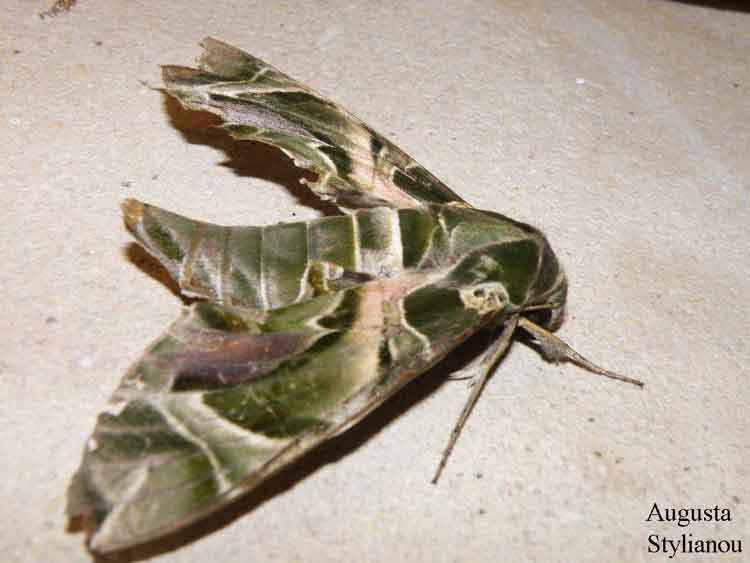
Daphnis nerii, Agios Mamas, Cyprus, Photo: Augusta Stylianou Artist
Superregnum: Eukaryota
Cladus: Unikonta
Cladus: Opisthokonta
Cladus: Holozoa
Regnum: Animalia
Subregnum: Eumetazoa
Cladus: Bilateria
Cladus: Nephrozoa
Cladus: Protostomia
Cladus: Ecdysozoa
Cladus: Panarthropoda
Phylum: Arthropoda
Subphylum: Hexapoda
Classis: Insecta
Cladus: Dicondylia
Subclassis: Pterygota
Cladus: Metapterygota
Infraclassis: Neoptera
Cladus: Eumetabola
Cladus: Endopterygota
Superordo: Panorpida
Cladus: Amphiesmenoptera
Ordo: Lepidoptera
Subordo: Glossata
Cladus: Coelolepida
Cladus: Myoglossata
Cladus: Neolepidoptera
Infraordo: Heteroneura
Cladus: Eulepidoptera
Cladus: Ditrysia
Cladus: Apoditrysia
Cladus: Obtectomera
Cladus: Macroheterocera
Superfamilia: Bombycoidea
Familia: Sphingidae
Subfamilia : Macroglossinae
Tribus: Macroglossini
Subtribus: Macroglossina
Genus: Daphnis
Species: Daphnis nerii
Name
Daphnis nerii (Linnaeus, 1758)
Synonyms
Sphinx nerii Linnaeus, 1758
Deilephila nerii f. bipartita Gehlen, 1934
Deilephila nerii f. confluens Closs, 1912
Daphnis nerii infernelutea Saalmüller, 1884
Daphnis nerii ab. nigra A.M. Schmidt, 1914

Daphnis nerii, Agios Mamas, Cyprus, Photo: Augusta Stylianou Artist
References
Eitschberger, U. & T. Melichar, 2010: Die Taxa der Gattung Daphnis Hübner, 1819, die Neugliederung der Unterarten von Daphnis hypothous (Cramer, 1780) mit neuer Unterart beschreibung und der Neotypusdesignation von Sphinx hypothous Cramer, 1780 (Lepidoptera: Sphingidae). The European Entomologist 2 (3-4): 49–91.
Vernacular names
English: Oleander Hawkmoth, Army green moth
српски / srpski: Олеандров љиљак / Oleandrov ljiljak, Олеандров лептир / Oleandrov leptir
svenska: Oleandersvärmare
Daphnis nerii, the oleander hawk-moth or army green moth, is a moth of the family Sphingidae. It was described by Carl Linnaeus in his 1758 10th edition of Systema Naturae.
Distribution
Daphnis nerii is a large hawk-moth found in wide areas of Africa, Asia and Hawaii. It is a migratory species, flying to parts of eastern and southern Europe during the summer, particularly Turkey, very occasionally reaching western Europe, including England.[3]
Feeding habits
The adults feed on nectar of a great variety of flowers. They have a preference for fragrant species like petunia, jasmine and honeysuckle. They are especially active in the twilight time, hovering over the flowers after sunset.
The caterpillars feed mainly on oleander (Nerium oleander) leaves, a highly toxic plant, to which the caterpillars are immune. They also may feed on most other plants of the dogbane family, such as Adenium obesum, Tabernaemontana divaricata and Alstonia scholaris in India. They also eat unbloomed flowers of Tabernaemontana divaricata at night. In England, where the species is one of the rarest migrant hawk-moths, a larva was discovered feeding on periwinkle Vinca minor. [3]
Biology
The adult has a greenish head, with rufous in front and a grey band on the vertex. The thorax is green, and the collar outlined in grey. There is a triangular grey patch on the vertex. Abdomen is pale greenish with oblique lines at the side paired dark green lateral blotches on the penultimate segment and a single dorsal blotch on the ultimate segment. Forewings are dark green and a white patch with a black spot on it at base. Some medial whitish conjoined bands, rosy towards the hind margin. There is a triangular purplish patch from below the cell to near outer margin. Hindwings are fuscous with a pale curved submarginal line, beyond which the area is olivaceus. Ventral side is suffused with chestnut colour and a white submarginal line on both wings. A white speck is present at the end of the hindwing.[4]
Eggs of oleander hawk moth in United Arab Emirates
Eggs of oleander hawk moth in United Arab Emirates
Newly hatched oleander hawk-moth larvae are three to four millimeters in length, bright yellow, and have a black, elongated "horn" on the rear of the body.[2][5] As they get older, the larvae become green to brown with a large blue-and-white eyespot near the head and a yellow "horn" on the rear.[2][5][6] There is also a white band along the side of the body, with a scattering of small white and bluish dots alongside it. The spiracles on the sides of the body are black.[2][6] Older oleander hawk-moth larvae measure around 7.5 to 8.5 centimetres in length.[6]
Just before it pupates, the oleander hawk-moth larva becomes browner in colour. The pupa of this species measures around 5.5 to 7.5 centimetres in length, and is light brown with black spots and a black line down the middle.[2][6] The pupa is pale reddish or brownish white and has a wax-like appearance. It lies directly on the earth, under moss or dry leaves.
Related species
Daphnis hypothous, found in South and Southeast Asia. Distinguished by a white spot at the forewing apex.[7]
References
"Fauna Europaea".
Pittaway, A. R. (2018). "Daphnis Hübner, [1819]". Sphingidae of the Western Palaearctic. Retrieved December 12, 2018.
Goater, B. (1974). The Butterflies and Moths of Hampshire and the Isle of Wight (Being an Account of the Whole of the Lepidoptera). E. W. Classey Ltd., Berkshire. ISBN 9780900848773
Hampson, G. F. (1892). The Fauna of British India, Including Ceylon and Burma: Moths Volume I. Taylor and Francis – via Biodiversity Heritage Library.
Moore, A. and Miller, R.H. (2008) Daphnis nerii (Lepidoptera: Sphingidae), a new pest of oleander on Guam, including notes on plant hosts and egg parasitism. Proceedings of the Hawaiian Entomological Society, 40: 67-70.
Leong, T.M. and D'Rozario, V. (2009) Final instar larvae and metamorphosis of the oleander hawkmoth, Daphnis nerii (Linnaeus) in Singapore (Lepidoptera: Sphingidae : Macroglossinae). Nature in Singapore, 2: 297-306.
Pittaway, A. R.; Kitching, I. J. "Daphnis hypothous crameri Eitschberger & Melichar, 2010 -- Jade hawkmoth". Sphingidae of the Eastern Palaearctic. Retrieved December 15, 2018.
Retrieved from "http://en.wikipedia.org/"
All text is available under the terms of the GNU Free Documentation License

